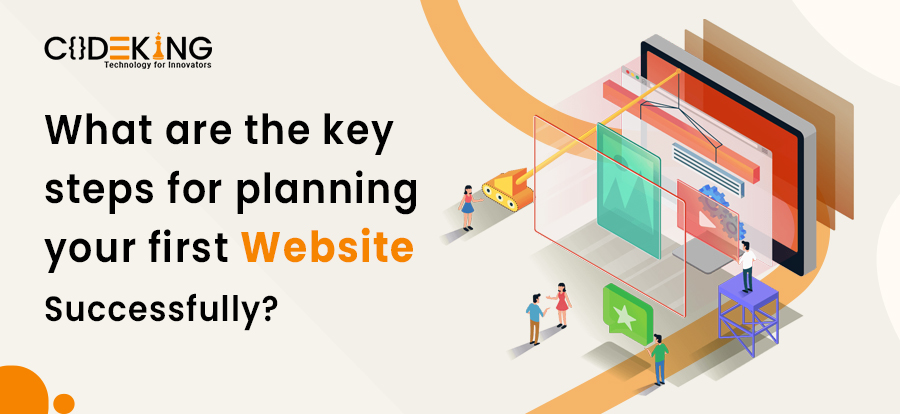As a business owner building your brand and promoting growth in the world of digitalization requires having a strong website. You must understand how to plan a website that will help you attract visitors. This will eventually help you represent your business and produce measurable results.
The process of creating a website starts with website planning. As a business owner, you should consider it as your online presence’s blueprint. This blueprint shows you the list of the objectives, target audience, and strategy for accomplishing your website goals. This method lays the strategic groundwork for your online presence thus resulting in a user-friendly website that satisfies visitors and meets your business objectives.
How to plan your first website successfully?
Starting your first website may be an exciting and fulfilling project, regardless of whether you’re a freelancer, small business owner, or aspiring blogger. However, with thorough planning and wise decision-making with the help of Website Design Services, you can make the website successful. Some of the ways to create your first website are as follows:
-
Define your goals and objectives
You need to have a clear idea of the objectives you are going to achieve while trying to make a website. You should keep a few things clear in your mind for what you are trying to make this website. Either you are trying to reach a wider audience, build a brand or boost sales. You should have smart goals for your business to make your ideas for the project successful.
a) Establish SMART goals.
SMART goals are one of the useful ways to split down your objectives as it helps you maintain concentration on the project. It stands for time, relevance, measurable, achievable, and specific.
- Specific: You should Clearly state your objectives. For instance, “reach page 1 on Google” or “increase online sales by 20% within the next year.”
- Measurable: Business owners should make sure that they have the data points or metrics to monitor their objectives. Traffic may be tracked using website analytics, and income can be tracked using internal sales monitoring.
- Achievable: Given your available resources and time, your objectives should be reasonable and doable.
- Relevant: You should always Verify that your objectives are essential to your success and that they are in line with your overall business objectives. If a fantastic website doesn’t help your business expand then it’s quite useless.
- Timely: To keep the project moving forward and sustain momentum, you must establish timelines for your objectives.
-
Develop a strategy and stick to it
As a business owner, you should Write up the plans and steps that are required to accomplish your SMART goals. This could involve the process of developing engaging content to draw in visitors. This can help in optimising the SEO to boost visibility or enhance website navigation for a better user experience (UX). It most likely means all of that and more in practice. You must track the development of your project against your SMART objectives. It’s time to review the plan when you start to deviate from it.
-
Understand your audience and your competitors
When creating a website, it is essential to comprehend your target audience to effectively meet their needs.
a) Identify your target audience: You should be certain who will be the main visitors to your website. You must think about things like geography, interests, education, age, gender, and special needs. It is important to create thorough personas for your average users. You must Provide details about their motives, difficulties, actions, and demographics. The personas should depict the kinds of users who are likely to visit your website. They are a great place to start if you don’t currently have anything to test, but they don’t replace testing with actual people.
b) Conduct Competitor Analysis: Analysing your consumers and studying other successful companies in your industry can sometimes provide you with greater insight into the market and how to flourish in it. Some of the ways you can conduct competitor analysis are as follows:
- Research Competitors: Determine who your direct competitors are and examine their websites.
- Analyse Their Website: You should know about the advantages and disadvantages of the websites. You should take into account some of the factors from design components to UX designs.
- Identify Differentiation Opportunities: Find out what makes your website unique. You should Look for market gaps that your website may close and distinctive value propositions that you can provide.
Make decisions about the main features and kinds of content your website will provide based on feedback from your audience and competition research. You should keep some of the priority lists and sort them according to what will best serve your users’ needs and preferences and set your website out from the competition.
-
Build your strategy
Create a strategy document by compiling your findings and conclusions. You may have to use this guide Throughout the design process, to make sure your website is unique from the competition and satisfies the needs of your target audience.
- Create a Content Strategy: You should Determine the kinds of material you will require, including documentation, photos, videos, and infographics. It is advisable to start by outlining or creating the text for your main pages. You should keep in mind the tone of the content that will appeal to your target audience.
- Make an SEO plan: Search Engine Optimization (SEO) needs to be taken into account right away. You must Make sure the coding and structure of your website are search engine optimised by conducting keyword research before creating any content. This will improve your website’s search engine ranking and help you draw in more users.
- Map Out the Structure of Your Website: You should begin to make a sitemap that lists every page you intend to have and their layout. It is advisable to make the navigation easier for the people when they are browsing the website.
- Design with accessibility and usability in mind: When creating a website, you need to take both usability and accessibility into account. The website needs to work properly across a range of platforms and browsers and it should follow all the accessibility guidelines.
- Select Your Technology Stack: The technology that will be used to run your website needs to be chosen correctly. This involves selecting a content management system (CMS), such as WordPress, or Drupal, or it can be customized as per your needs and preferences. The website should have the front-end and back-end programming languages and frameworks that best suit the needs of your project.
It’s time to get the help of Web Design Services India if you don’t know the answers to these questions. It never hurts to run your ideas by a developer, even if you’re an experienced designer. New technologies are always being released into the market, and you can miss out on a perfectly good solution.
-
Set a timeline and budget
Business owners need to make sure that they have established a time frame and a budget to simplify the planning process to make a website.
- Establish reasonable deadlines: You must Divide the project into stages, such as content generation, development, and design. It is important to Give each stage a reasonable completion date, taking into account the resources and level of complexity. For a coherent timeline, make sure every date is to your overall project objectives.
- Make a thorough budget: It is important to List every element of the project, such as the design, development, content production, and any outside services that are required.
You must Calculate each element’s cost using consulting quotations, completed projects, or industry norms. It is advisable to keep some extra money for additional expenses to prevent going over budget. You must keep track of the budget and modify it whenever needed.
By keeping an eye on these details, you’ll be able to control the budget of implementing a website project.
To conclude, Establishing a website is simple, but creating a profitable website that doesn’t drain your bank account is a little more difficult. To build a website that follows your entire business objectives, you must exercise discipline throughout the process. You must use SMART goals to lay a solid foundation for your project objectives. Having a formal structure from the beginning will get you off to a good start, even though you may need to adjust at some point during the project. Building a website that your audience finds useful requires a thorough understanding of them and their needs. To convey these insights, your site architecture and technology stack should be compatible. If you do it well, you will attract new users while keeping existing ones. By using a comprehensive strategy, you can be sure that your website will satisfy user needs and corporate objectives while also looking good.
FAQs:
- How can you start a successful website?
Businesses need to set clear objectives and you must figure out who your target market is. You must choose a memorable domain name and web hosting that will help in organising the structure of your design. The website must produce engaging content and it should be optimised for the search engines to have greater visibility. You must make sure that it is mobile-friendly and has all security measures
- Why is SEO implemented in the website?
The goal of SEO (Search Engine Optimization) is to increase the organic traffic of the website and improve the rating on the search engines. With the help of technical content, meta tags, and keyword optimization, it will increase the chance of bringing customers to your website when they are looking for any products or services online.
- What are the 4 stages of website planning?
The process of developing a website involves four steps
- Defining goals and objectives
- Comprehending target audience and conducting market research
- Organising the structure, design, and content of the website and
- Putting SEO methods into practice, testing the website, and launching it.




